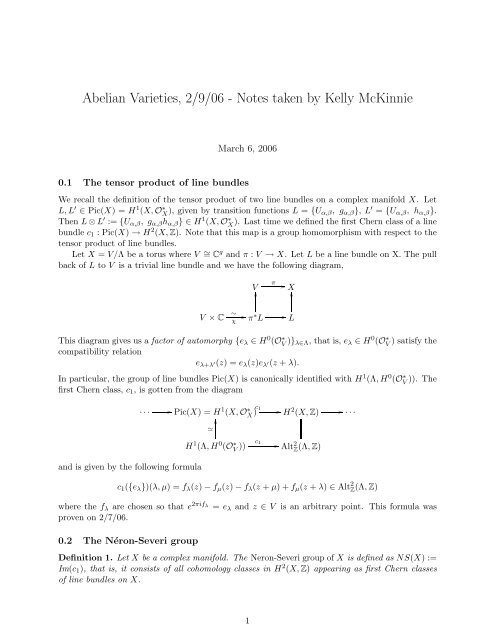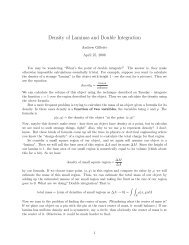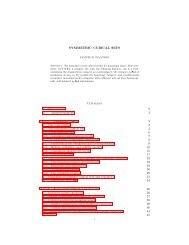Abelian Varieties, 2/9/06 - Notes taken by Kelly McKinnie
Abelian Varieties, 2/9/06 - Notes taken by Kelly McKinnie
Abelian Varieties, 2/9/06 - Notes taken by Kelly McKinnie
You also want an ePaper? Increase the reach of your titles
YUMPU automatically turns print PDFs into web optimized ePapers that Google loves.
<strong>Abelian</strong> <strong>Varieties</strong>, 2/9/<strong>06</strong> - <strong>Notes</strong> <strong>taken</strong> <strong>by</strong> <strong>Kelly</strong> <strong>McKinnie</strong><br />
March 6, 20<strong>06</strong><br />
0.1 The tensor product of line bundles<br />
We recall the definition of the tensor product of two line bundles on a complex manifold X. Let<br />
L, L ′ ∈ Pic(X) = H1 (X, O∗ X ), given <strong>by</strong> transition functions L = {Uα,β, gα,β}, L ′ = {Uα,β, hα,β}.<br />
Then L ⊗ L ′ := {Uα,β, gα,βhα,β} ∈ H1 (X, O∗ X ). Last time we defined the first Chern class of a line<br />
bundle c1 : Pic(X) → H 2 (X, Z). Note that this map is a group homomorphism with respect to the<br />
tensor product of line bundles.<br />
Let X = V/Λ be a torus where V ∼ = C g and π : V → X. Let L be a line bundle on X. The pull<br />
back of L to V is a trivial line bundle and we have the following diagram,<br />
V × C ∼<br />
χ<br />
V��<br />
��<br />
π∗L This diagram gives us a factor of automorphy {eλ ∈ H0 (O∗ V )}λ∈Λ, that is, eλ ∈ H0 (O∗ V ) satisfy the<br />
compatibility relation<br />
π �<br />
� X�<br />
�<br />
��<br />
L<br />
eλ+λ ′(z) = eλ(z)eλ ′(z + λ).<br />
In particular, the group of line bundles Pic(X) is canonically identified with H1 (Λ, H0 (O∗ V )). The<br />
first Chern class, c1, is gotten from the diagram<br />
and is given <strong>by</strong> the following formula<br />
. . . ��<br />
Pic(X) = H1 (X, O∗ X ) c1 ��<br />
H2 (X, Z)<br />
��<br />
�<br />
H 1 (Λ, H 0 (O ∗ V ))<br />
c1 ��<br />
2<br />
AltZ (Λ, Z)<br />
��<br />
. . .<br />
c1({eλ})(λ, µ) = fλ(z) − fµ(z) − fλ(z + µ) + fµ(z + λ) ∈ Alt 2 Z(Λ, Z)<br />
where the fλ are chosen so that e 2πifλ = eλ and z ∈ V is an arbitrary point. This formula was<br />
proven on 2/7/<strong>06</strong>.<br />
0.2 The Néron-Severi group<br />
Definition 1. Let X be a complex manifold. The Neron-Severi group of X is defined as NS(X) :=<br />
Im(c1), that is, it consists of all cohomology classes in H 2 (X, Z) appearing as first Chern classes<br />
of line bundles on X.<br />
1
We will describe the Neron-Severi group of a torus. Recall if E = c1(L) where L is a line bundle<br />
on a torus X, then E : Λ × Λ → Z is a Z-alternating form and tensoring this with R we obtain an<br />
R-alternating form E : V × V → R.<br />
Theorem 0.1. For an R-alternating form E : V × V → R, the following are equivalent:<br />
1. E = c1(L) for a line bundle L → X.<br />
2. E(Λ, Λ) ⊆ Z, and E(ix, iy) = E(x, y) for all x, y ∈ V .<br />
Proof. From the short exact sequence of sheaves 0 → Z → OX → O∗ X → 0 we get the following<br />
long exact sequence of cohomology.<br />
· · ·<br />
��<br />
H1 (OX)<br />
��<br />
H1 (O∗ X )<br />
c1 ��<br />
H2 (X, Z)<br />
α ��<br />
H2 (OX)<br />
By definition NS(X) is the kernel of α. By extending scalars from Z to C, where both Z and C are<br />
viewed as constant sheaves, we get the following square, which we are going to show is commutative.<br />
H 2 (X, Z)<br />
α ��<br />
��<br />
H2 (X, C) proj<br />
H 2 (OX)<br />
��<br />
0,2<br />
HDol (X)<br />
The equality on the right hand side is from Dolbeault’s theorem, Hq (Ω p<br />
X<br />
) = Hp,q<br />
Dol (X). The map on<br />
the left hand side of (1) is extension of scalars from Z to C. To see that (1) commutes, we consider<br />
the following morphism of complexes.<br />
0<br />
0<br />
��<br />
C�<br />
�<br />
inc<br />
��<br />
��<br />
OX<br />
��<br />
A 0 X<br />
π proj<br />
��<br />
��<br />
0,0<br />
A<br />
X<br />
d ��<br />
A1 X<br />
¯∂ �<br />
d ��<br />
· · ·<br />
��<br />
� ��<br />
π proj<br />
0,1<br />
AX ¯∂<br />
· · ·<br />
The top row of (2) is used to compute de Rham cohomology, the bottom row of (2) is used to<br />
compute (0, n)-Dolbeault cohomology. This really is a morphism of complexes, that is the squares<br />
commute. We can see this for the second square as follows. Let f ∈ A 0 X .<br />
� ��<br />
��<br />
f(z)<br />
�<br />
d ∂f ∂f<br />
∂z dz + ∂¯z d¯z<br />
��<br />
�<br />
proj<br />
f(z) � ��<br />
∂¯ ∂f ¯ ∂f<br />
= ∂¯z d¯z<br />
The morphism of complexes (2) gives us an induced projection map proj : Hn dR (X) → H(0,n)<br />
Dol (X).<br />
By de Rham’s theorem, H n (X, C) ∼ = H n dR (X), and <strong>by</strong> Dolbeault’s theorem Hn (OX) ∼ = H (0,n)<br />
Dol (X).<br />
The induced map i : H n (X, C) → H n (OX) is really projection from the Hodge decomposition of<br />
H n (X, C) to H n (OX). The following diagram is commutative.<br />
H n (X, C)<br />
i<br />
��<br />
H n (OX)<br />
∼ ��<br />
Hn dR (X)<br />
∼ �<br />
proj<br />
��<br />
� H 0,n<br />
Dol (X)<br />
Applying this for n = 2 we get that (1) is commutative. To see that the map on the right is really<br />
projection, we first recall the following definitions.<br />
2<br />
��<br />
. . .<br />
(1)<br />
(2)
H q (Ω p<br />
X ) = � p Ω ⊗ � q Ω = H p,q<br />
Dol (X)<br />
where Ω = HomC(V, C) and Ω = HomC−anti(V, C) and<br />
Hn �<br />
dR (X, C) = p+q=n Hp,q (X).<br />
Therefore, H 2 dR (X, C) = � 2 Ω ⊕ (Ω ⊗ Ω) ⊕ � 2 Ω, H 0,2<br />
Dol (X) = � 2 Ω, and the map between them<br />
is really projection. We are now almost done. Let E ∈ H 2 (X, Z) with α(E) = 0. Then write E<br />
in it’s decomposition E = E1 + E2 + E3 with E1 ∈ � 2 Ω, E2 ∈ Ω ⊗ Ω and E3 ∈ � 2 Ω. By the<br />
commutativity of (1) α(E) = E3, and therefore E3 = 0.<br />
Exercise 0.2. Let E : V × V → C an R alternating form. Show E(V × V ) ⊆ R if and only if<br />
E1 = E3.<br />
This exercise implies that E1 = E3 = 0, and therefore, E = E2, that is, it is a (1,1) form. The<br />
(1,1)-forms are precisely those that satisfy E(ix, iy) = E(x, y). To see this, let f ⊗ g ∈ Ω ⊗ Ω, a<br />
simple tensor, where f : V → C is C-linear and g : V → C is C-anti-linear. We now check that<br />
f ⊗ g(ix, iy) = f ⊗ g(x, y):<br />
f ⊗ g(ix, iy) = f(ix)g(iy)<br />
= if(x)(−i)g(y)<br />
= f(x)g(y) = f ⊗ g(x, y)<br />
Exercise 0.3. Show Ω ⊗ Ω = {E : V × V → C | E(ix, iy) = E(x, y)}. Just above we proved “⊆”.<br />
To prove the other inclusion count dimensions.<br />
With this the theorem has been proved.<br />
Corollary 0.4. There exists a bijection between NS(X) and the space of Hermitian forms H :<br />
V × V → C such that ImH(Λ, Λ) ⊆ Z.<br />
Recall a form is said to be Hermitian if it is C-linear and H(x, y) = H(y, x).<br />
Proof. By Theorem 0.1, NS(X) = {E : V × V → R, alternating | E(Λ, Λ) ⊆ Z, with E(ix, iy) =<br />
E(x, y)}. The bijection takes<br />
E ↦→ H : V × V → C<br />
where H(x, y) = E(ix, y) + iE(x, y). We need to check that this is a Hermitian form:<br />
0.3 The Appell-Humbert Theorem<br />
H(y, x) = E(iy, x) − iE(y, x) = −E(y, ix) − iE(y, x)<br />
= E(ix, y) + iE(x, y) = H(x, y)<br />
The Appell-Humbert Theorem was proved <strong>by</strong> Appell and Humbert in the 1890’s for dimension 2.<br />
It was proved <strong>by</strong> Lefschetz in general. It is the most important theorem so far in the class. Recall<br />
our general set up, L → X = V/Λ, a line bundle. From L we get factors of automorphy {eλ}.<br />
We would like to get a canonical factor of automorphy representing L, that is, a distinguished<br />
representative.<br />
Definition 2. A semi-character for H ∈ NS(X) is a map χ : Λ → S 1 = {z ∈ C | |z| = 1} such<br />
that<br />
χ(λ + λ ′ ) = χ(λ)χ(λ ′ )e πiE(λ,λ′ ) .<br />
3<br />
(3)
Example: H = 0; the semi-characters for 0 are Hom(Λ, S 1 ).<br />
Definition 3. P(Λ) = {(H, χ) | H ∈ NS(X), χ is a semi-character for H}.<br />
P(Λ) is a group with operation (H1, χ1)(H2, χ2) = (H1 + H2, χ1χ2). There exists an exact<br />
sequence<br />
1 ��<br />
Hom(Λ, S1 p<br />
) ��<br />
P(Λ) ��<br />
NS(X).<br />
p is the “forget the semi-character” map. It is not clear yet that p is surjective, but it will be true.<br />
In fact, we will eventually have Pic(X) ∼ = P(Λ), where the map is defined as follows.<br />
P(Λ)<br />
a ��<br />
Pic(X) ∼<br />
can ��<br />
H1 (Λ, H0 (O∗ V )) (factors of automorphy)<br />
(H, χ) � a ��<br />
L(H, χ)<br />
where a(H, χ) = L(H, χ) is the line bundle given <strong>by</strong> the factors of automorphy<br />
π<br />
πH(z,λ)+<br />
a(H, χ) = {aλ(z) = χ(λ)e 2 H(λ,λ) }λ ∈ H 0 (O ∗ V ).<br />
We need to show that this definition makes {aλ} into a factor of automorphy, that is, we need to<br />
show that aλ+λ ′(z) = aλ(z)aλ ′(z + λ):<br />
aλ+λ ′(z) = χ(λ + λ′ )e πH(z,λ+λ′ )+ π<br />
2 H(λ+λ′ ,λ+λ ′ )<br />
= χ(λ)χ(λ ′ )e πiE(λ,λ′ ) e πH(z,λ ′ )+πH(z,λ)+ π<br />
2 [H(λ,λ)+H(λ′ ,λ ′ )+H(λ,λ ′ )+H(λ ′ ,λ)]<br />
�<br />
= χ(λ)e<br />
�<br />
= χ(λ)e<br />
π<br />
πH(z,λ)+ 2<br />
π<br />
πH(z,λ)+ 2<br />
= aλ(z)aλ ′(z + λ)<br />
H(λ,λ)� �<br />
χ(λ ′ )e πH(z,λ′ )+ π<br />
2 H(λ′ ,λ ′ ) e πiE(λ,λ ′ )+πRe(H(λ,λ ′ )) �<br />
H(λ,λ)� �<br />
χ(λ ′ )e πH(z+λ,λ′ )+ π<br />
2 H(λ′ ,λ ′ ) �<br />
The 4-th equality follows from the relation H(x, y) = E(ix, y) + iE(x, y).<br />
The Appell-Humbert Theorem says that a : P(Λ) → Pic(X) is an isomorphism. We will prove<br />
this next time. This gives a geometric description of what all line bundles look like. Because, as a<br />
total space, we have:<br />
L(H, χ) = V × C/ ∼<br />
where (z, t) ∼ (z + λ, aλ(z)t).<br />
Proposition 0.5. The diagram<br />
��<br />
��<br />
�<br />
P(Λ)<br />
����<br />
�p<br />
����<br />
a<br />
Pic(X)<br />
c1<br />
���������� NS(X)<br />
is commutative where p is the “forget the semi-character” map. In particular, c1(L(H, χ)) = H.<br />
4




